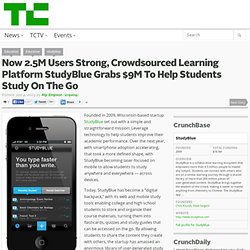

EduClipper Launches Its “Pinterest For Education” To Bring Better Crowdsourced Curation & Sharing To The Classroom. Back in 2007, Adam Bellow launched a site called eduTecher to aggregate and surface the best educational resources and content on the web.

A high school teacher, Bellow set out to highlight new technologies and educational tools that could be used in the classroom to improve the learning experience. With Google Play For Education, Google Looks To Challenge Apple’s Dominance In The Classroom. Google I/O, the company’s sixth annual developer conference, got officially underway in San Francisco on Wednesday, and it was an eventful day.

It took the company every minute of its epic three-hour keynote to unfurl a laundry list of announcements and updates, seemingly across every product category in its arsenal — from Android, Chrome and Search to Maps, Google+ and Hangouts — each with a fresh coat of paint. We even saw the arrival of Google’s very own subscription music service, today, which is already being touted as a potential Spotify killer. Desire2Learn’s New Learning Suite Aims To Predict Success, Change How Students Navigate Their Academic Career. Desire2Learn is a 10-plus year old Canadian company that makes learning software — a learning management system to be precise — and here’s why, in spite of that description, it shouldn’t bore you to sleep.

In a space that’s traditionally been controlled by bigs like Blackboard and Moodle, Desire2Learn has quietly managed to carve out its own growing share of the market. Last September, the Waterloo-based company raised a sizable $80 million round from NEA and others, and today has over 700 clients and more than 10 million people across higher education, K-12, healthcare and beyond are using its learning software. MeeGo To MOOCs, Ex-Nokians Launch Eliademy To Put Education In The Cloud. Legend has it that Anssi Vanjoki, the ex-Nokia VP who many inside the company once thought would be its next CEO, used to refer to the now-defunct MeeGo OS team as the “Alpha team” based on their hard work and ability to produce results with limited resources.

It perhaps shouldn’t be a surprise then to learn that more than one startup has been created by members of the MeeGo alumni. In that group, alongside Jolla — the mobile phone upstart hoping to resurrect the fortunes of Nokia’s abandoned open source OS — is the equally ambitious CBTec, which has its sights set on the $18 billion online learning industry. It’s recently launched Eliademy, a free, cloud-based VLE to initially take on legacy players like Blackboard, but with broader plans to become a leading MOOC (Massively Open Online Course), pitting it against Kleiner-backed Coursera, among many others in the fast-growing MOOC space.
Online Education Is Replacing Physical Colleges At A Crazy Fast Pace. Educators knew the online revolution would eventually envelop the physical classroom, but a torrent of near-revolutionary developments in the past month are proving that change is coming quicker than anyone imagined.

In just 30 days, the largest school system in the U.S. began offering credit for online courses, a major university began awarding degrees without any class time required, and scores of public universities are moving their courses online. The point at which online higher education becomes mainstream is no longer in some fuzzy hypothetical future; the next president’s Secretary of Education will need an entire department dedicated to the massive transition. For over a decade, admissions-selective universities (e.g. not the University of Phoenix) resisted giving credit for their overwhelmingly popular online courses.
I was wrong about one thing: the otherwise scientifically prudent community of higher education didn’t wait to see if the pilot was successful. Now 2.5M Users Strong, Crowdsourced Learning Platform StudyBlue Grabs $9M To Help Students Study On The Go. Founded in 2009, Wisconsin-based startup StudyBlue set out with a simple and straightforward mission: Leverage technology to help students improve their academic performance.

Over the next year, with smartphone adoption accelerating, that took a more defined shape, with StudyBlue becoming laser-focused on mobile to allow students to study anywhere and everywhere — across devices. Today, StudyBlue has become a “digital backpack,” with its web and mobile study tools enabling college and high school students to store and organize their course materials, turning them into flashcards, quizzes and study guides that can be accessed on the go. By allowing students to share the content they create with others, the startup has amassed an enormous library of user-generated study materials — over 100 million in total — which cover a wide array of subjects, from zoology to anthropology. With $100M From The Gates Foundation & Others, inBloom Wants To Transform Education By Unleashing Its Data. In 2012, the buzz around education technology reached new heights and, with the new year now underway, the hype surrounding the potential transformative impact of technology on both higher and K-12 education continues.

The examples are many, but the most salient, recent example would have to be the pilot that the largest university system in the world is set to launch, which will attempt to bring affordable, lower-division, remedial (and Udacity-powered) online courses to the California State University system. Of late, we’ve seen growing interest in education technology across the board, from venture capitalists and entrepreneurs to state and federal governments. Lynda.com Deal Solidifies Online Education Boom. Forty years ago, the United States government spent $16 billion on workforce and job training programs.

Today, it spends less than half that amount. It's up to the private sector to fill the gap. After 17 Years, Education Platform Lynda.com Raises Its First Round Of Funding, $103M From Accel & Spectrum. Back in May, we shared the unique story of Lynda.com, the veteran, video-based education platform, and how it was able to generate $70 million in revenue in 2011 without taking a penny from outside investors.

Since then, it’s continued chugging along, growing revenue to $100 million in 2012. Founded in 1995 by husband-and-wife team Bruce Heavin and Lynda Weinman, Lynda.com is not your typical tech startup. How California’s Online Education Pilot Will End College As We Know It. Today, the largest university system in the world, the California State University system, announced a pilot for $150 lower-division online courses at one of its campuses — a move that spells the end of higher education as we know it.

Lower-division courses are the financial backbone of many part-time faculty and departments (especially the humanities). As someone who has taught large courses at a University of California, I can assure readers that my job could have easily been automated. Most of college–the expansive campuses and large lecture halls–will crumble into ghost towns as budget-strapped schools herd students online. Microsoft Invests $75 Million To Expand Digital Education In Africa. An error occurred with this part of the page, sorry for the inconvenience. 10 EdTech Innovations for January 2013. EdTech innovations now allow collaborative blackboarding, virtual language immersion and online microbiology labs for aspiring scientists. Creative minds in educational technology are finding ways to amp up the learning process and help both teachers and students organize data. Here's an alphabetical list of 10 companies taking leaps forward in the EdTech world and a little bit about the tools they're building for today's students and educators.
BiblioNasium: BiblioNasium aims to help children find a passion for books, mirroring the personal need of book-loving parent and co-founder Marjan Ghara. This virtual village for readers lets kids share book recommendations with each other, track their progress with reading logs and search for other books at their reading level. Coursera Takes A Big Step Toward Monetization, Now Lets Students Earn “Verified Certificates” For A Fee. Stanford professors Daphne Koller and Andrew Ng launched Coursera last year to give anyone and everyone access to courses from top-tier universities — for free, online.
'Badges' Earned Online Pose Challenge to Traditional College Diplomas - College 2.0. By Jeffrey R. Young The spread of a seemingly playful alternative to traditional diplomas, inspired by Boy Scout achievement patches and video-game power-ups, suggests that the standard certification system no longer works in today's fast-changing job market. Educational upstarts across the Web are adopting systems of "badges" to certify skills and abilities. With 4.5M Users, Instructure Takes On The Courseras & Udacities Of The World With Its Own Open Course Network. Instructure launched Canvas in 2011 to give educational institutions an alternative to the ubiquitous (but much criticized) software of educational giants like Blackboard.
The Gamification of Education Infographic #gamification #edtech.
Your Online Ivy: Coursera Now Hosts 200 Courses From 33 Schools & Reaches 1.3M Students. For decades, the door to America’s top-tier universities has been closing, and today your chances of being admitted to these prestigious institutions is slimmer than ever. This year, the acceptance rate at four of the eight Ivy League schools hit record lows. Class2Go: Stanford’s New Open-Source Platform For Online Education. The cost of higher education in the U.S. today is ridiculous. Student debt shot north of $1 trillion earlier this year, for example. Digital Learning Now. La Contra: Roger Schank. Now In 600+ Schools And Open To Any Student, Lore Gives Higher Ed A Next-Gen Social Network. Anticipating a Blended Classroom Boom Led by Education Startups.
As kids head back to school this month and next, some will find a rather new arrangement greeting them: blended classrooms.